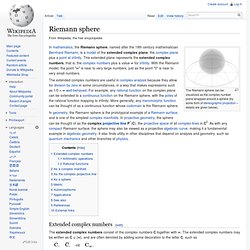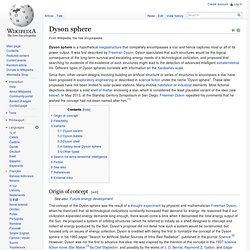

Riemann sphere. The Riemann sphere can be visualized as the complex number plane wrapped around a sphere (by some form of stereographic projection – details are given below).

In mathematics, the Riemann sphere, named after the 19th century mathematician Bernhard Riemann, is a model of the extended complex plane, the complex plane plus a point at infinity. This extended plane represents the extended complex numbers, that is, the complex numbers plus a value ∞ for infinity. With the Riemann model, the point "∞" is near to very large numbers, just as the point "0" is near to very small numbers. In geometry, the Riemann sphere is the prototypical example of a Riemann surface, and is one of the simplest complex manifolds.
In projective geometry, the sphere can be thought of as the complex projective line P1(C), the projective space of all complex lines in C2. Extended complex numbers[edit] The extended complex numbers consist of the complex numbers C together with ∞. Arithmetic operations[edit] Metric[edit] Dyson sphere. Dyson sphere is a hypothetical megastructure that completely encompasses a star and hence captures most or all of its power output.

It was first described by Freeman Dyson. Dyson speculated that such structures would be the logical consequence of the long-term survival and escalating energy needs of a technological civilization, and proposed that searching for evidence of the existence of such structures might lead to the detection of advanced intelligent extraterrestrial life. Different types of Dyson spheres correlate with information on the Kardashev scale. Since then, other variant designs involving building an artificial structure or series of structures to encompass a star have been proposed in exploratory engineering or described in science fiction under the name "Dyson sphere". These later proposals have not been limited to solar-power stations. Origin of concept[edit] Feasibility[edit] Variants[edit] Dyson swarm[edit] A Dyson ring — the simplest form of the Dyson swarm — to scale.
Schwarzschild radius. The relation between properties of mass and their associated physical constants.

Every massive object is believed to exhibit all five properties. However, due to extremely large or extremely small constants, it is generally impossible to verify more than two or three properties for any object. The Schwarzschild radius (rs) represents the ability of mass to cause curvature in space and time.The standard gravitational parameter (μ) represents the ability of a massive body to exert Newtonian gravitational forces on other bodies.Inertial mass (m) represents the Newtonian response of mass to forces.Rest energy (E0) represents the ability of mass to be converted into other forms of energy.The Compton wavelength (λ) represents the quantum response of mass to local geometry. History[edit] In 1916, Karl Schwarzschild obtained an exact solution[2][3] to Einstein's field equations for the gravitational field outside a non-rotating, spherically symmetric body (see Schwarzschild metric).
Where: Spin (physics) In quantum mechanics and particle physics, spin is an intrinsic form of angular momentum carried by elementary particles, composite particles (hadrons), and atomic nuclei.[1][2] Spin is a solely quantum-mechanical phenomenon; it does not have a counterpart in classical mechanics (despite the term spin being reminiscent of classical phenomena such as a planet spinning on its axis).[2] Spin is one of two types of angular momentum in quantum mechanics, the other being orbital angular momentum.

Orbital angular momentum is the quantum-mechanical counterpart to the classical notion of angular momentum: it arises when a particle executes a rotating or twisting trajectory (such as when an electron orbits a nucleus).[3][4] The existence of spin angular momentum is inferred from experiments, such as the Stern–Gerlach experiment, in which particles are observed to possess angular momentum that cannot be accounted for by orbital angular momentum alone.[5] where h is the Planck constant.